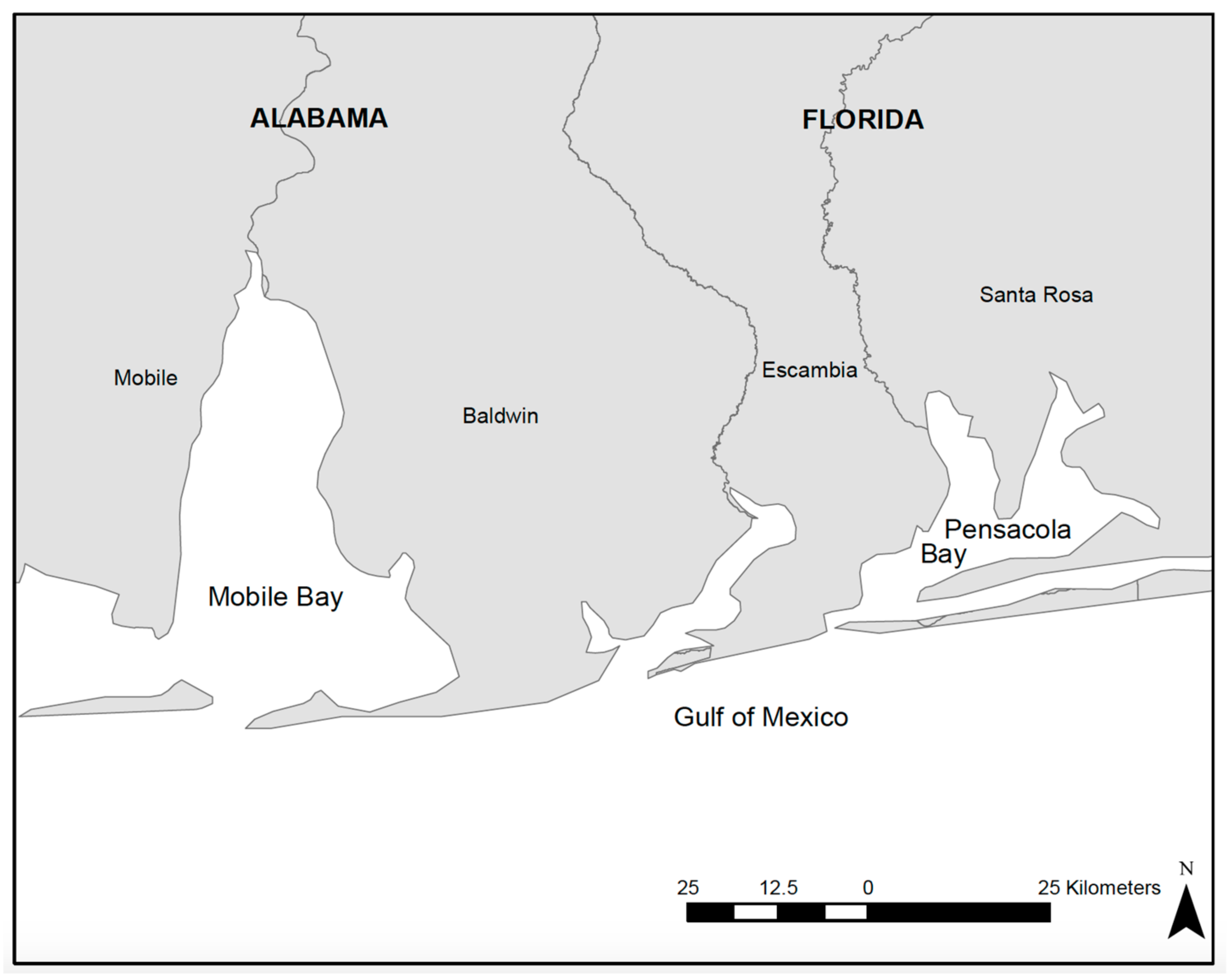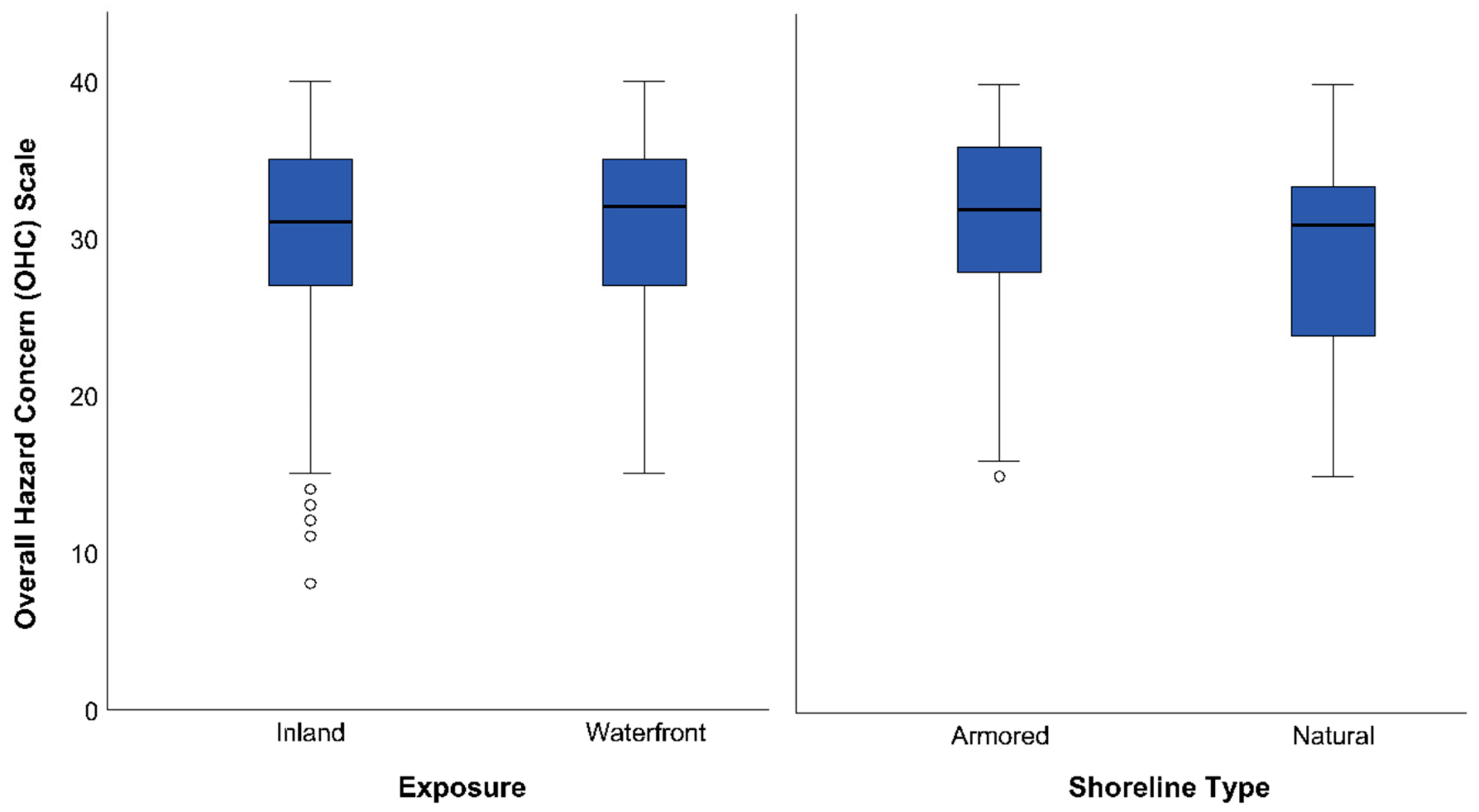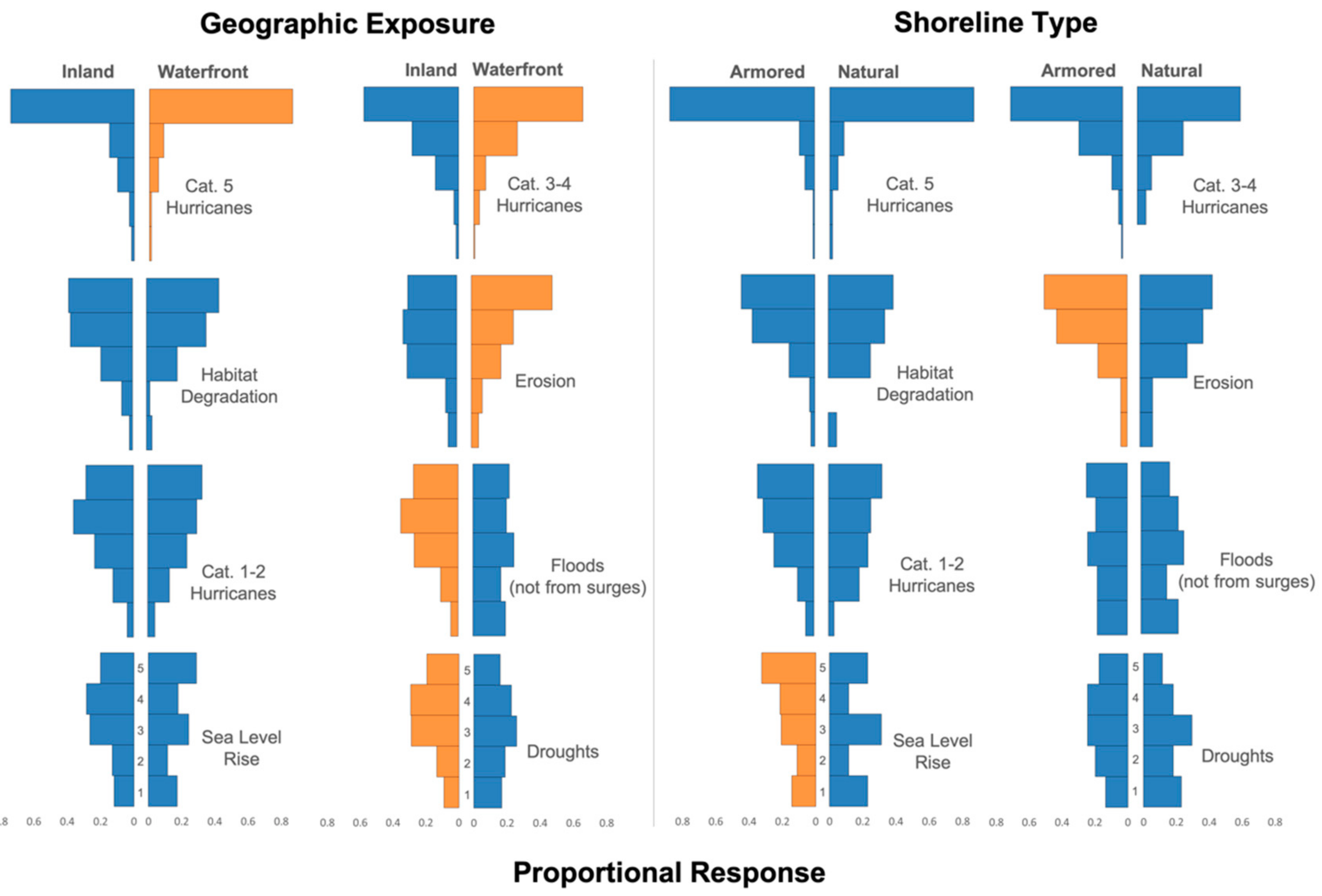A Waterfront View of Coastal Hazards: Contextualizing Relationships among Geographic Exposure, Shoreline Type, and Hazard Concerns among Coastal Residents
Abstract
:1. Introduction
2. Materials and Methods
3. Results
3.1. Survey Sample and Demographics
3.2. Waterfront Exposure, Shoreline Condition, and Hazard Concern
4. Discussion
Author Contributions
Funding
Acknowledgments
Conflicts of Interest
References
- Burger, J.; O’Neill, K.M.; Handel, S.N.; Hensold, B.; Ford, G. The shore is wider than the beach: Ecological planning solutions to sea level rise for the Jersey Shore, USA. Landsc. Urban Plan. 2017, 157, 512–522. [Google Scholar] [CrossRef]
- Landry, C.E. Coastal Erosion as a Natural Resource Management Problem: An Economic Perspective. Coast. Manag. 2011, 39, 259–281. [Google Scholar] [CrossRef]
- Narayan, S.; Beck, M.W.; Reguero, B.G.; Losada, I.J.; van Wesenbeeck, B.; Pontee, N.; Sanchirico, J.N.; Ingram, J.C.; Lange, G.-M.; Burks-Copes, K.A. The Effectiveness, Costs and Coastal Protection Benefits of Natural and Nature-Based Defences. PLoS ONE 2016, 11, e0154735. [Google Scholar] [CrossRef] [PubMed]
- Arkema, K.K.; Guannel, G.; Verutes, G.; Wood, S.A.; Guerry, A.; Ruckelshaus, M.; Kareiva, P.; Lacayo, M.; Silver, J.M. Coastal habitats shield people and property from sea-level rise and storms. Nat. Clim. Chang. 2013, 3, 913. [Google Scholar] [CrossRef]
- Narayan, S.; Beck, M.W.; Wilson, P.; Thomas, C.J.; Guerrero, A.; Shepard, C.C.; Reguero, B.G.; Franco, G.; Ingram, J.C.; Trespalacios, D. The Value of Coastal Wetlands for Flood Damage Reduction in the Northeastern USA. Sci. Rep. 2017, 7, 9463. [Google Scholar] [CrossRef]
- Tomiczek, T.; Kennedy, A.; Zhang, Y.; Owensby, M.; Hope, M.E.; Lin, N.; Flory, A. Hurricane damage classification methodology and fragility functions derived from Hurricane Sandy’s effects in Coastal New Jersey. J. Waterway Port Coast. Ocean Eng. 2017, 143, 04017027. [Google Scholar] [CrossRef]
- Kittinger, J.N.; Ayers, A.L. Shoreline Armoring, Risk Management, and Coastal Resilience Under Rising Seas. Coast. Manag. 2010, 38, 634–653. [Google Scholar] [CrossRef]
- National Research Council; Division on Earth and Life Studies; Ocean Studies Board; Committee on Mitigating Shore Erosion Along Sheltered Coasts. Mitigating Shore Erosion Along Sheltered Coasts; National Academies Press: Washington, DC, USA, 2007; ISBN 9780309103466. [Google Scholar]
- Gittman, R.K.; Fodrie, F.J.; Popowich, A.M.; Keller, D.A.; Bruno, J.F.; Currin, C.A.; Peterson, C.H.; Piehler, M.F. Engineering away our natural defenses: An analysis of shoreline hardening in the US. Front. Ecol. Environ. 2015, 13, 301–307. [Google Scholar] [CrossRef]
- Bilkovic, D.M.; Roggero, M.M. Effects of coastal development on nearshore estuarine nekton communities. Mar. Ecol. Prog. Ser. 2008, 358, 27–39. [Google Scholar] [CrossRef]
- Scyphers, S.B.; Picou, J.S.; Powers, S.P. Participatory conservation of coastal habitats: The importance of understanding homeowner decision making to mitigate cascading shoreline degradation. Conserv. Lett. 2015. [Google Scholar] [CrossRef]
- Smith, C.S.; Gittman, R.K.; Neylan, I.P.; Scyphers, S.B. Hurricane damage along natural and hardened estuarine shorelines: Using homeowner experiences to promote nature-based coastal protection. Mar. Policy 2017. [Google Scholar] [CrossRef]
- Gittman, R.K.; Peterson, C.H.; Currin, C.A.; Fodrie, F.J.; Piehler, M.F.; Bruno, J.F. Living shorelines can enhance the nursery role of threatened estuarine habitats. Ecol. Appl. 2016, 26, 249–263. [Google Scholar] [CrossRef] [PubMed]
- Scyphers, S.B.; Powers, S.P.; Heck, K.L., Jr.; Byron, D. Oyster reefs as natural breakwaters mitigate shoreline loss and facilitate fisheries. PLoS ONE 2011, 6, e22396. [Google Scholar] [CrossRef] [PubMed]
- Piazza, B.P.; Banks, P.D.; La Peyre, M.K. The Potential for Created Oyster Shell Reefs as a Sustainable Shoreline Protection Strategy in Louisiana. Restor. Ecol. 2005, 13, 499–506. [Google Scholar] [CrossRef]
- Smith, C.S.; Puckett, B.; Gittman, R.K.; Peterson, C.H. Living shorelines enhanced the resilience of saltmarshes to Hurricane Matthew (2016). Ecol. Appl. 2018, 28, 871–877. [Google Scholar] [CrossRef]
- Shepard, C.C.; Crain, C.M.; Beck, M.W. The protective role of coastal marshes: A systematic review and meta-analysis. PLoS ONE 2011, 6, e27374. [Google Scholar] [CrossRef]
- Reguero, B.G.; Beck, M.W.; Bresch, D.N.; Calil, J.; Meliane, I. Comparing the cost effectiveness of nature-based and coastal adaptation: A case study from the Gulf Coast of the United States. PLoS ONE 2018, 13, e0192132. [Google Scholar] [CrossRef]
- Beck, M.W.; Brumbaugh, R.D.; Airoldi, L.; Carranza, A. Oyster reefs at risk and recommendations for conservation, restoration, and management. Bioscience 2011. [Google Scholar] [CrossRef]
- Dillman, D.A.; Smyth, J.D.; Christian, L.M. Internet, Phone, Mail, and Mixed-Mode Surveys: The Tailored Design Method; John Wiley & Sons: Hoboken, NJ, USA, 2014; ISBN 9781118921302. [Google Scholar]
- Smith, C.S.; Scyphers, S. Past hurricane damage and flood zone outweigh shoreline hardening for predicting residential-scale impacts of Hurricane Matthew. Environ. Sci. Policy 2019, 101, 46–53. [Google Scholar] [CrossRef]
- Gittman, R.K.; Popowich, A.M.; Bruno, J.F.; Peterson, C.H. Marshes with and without sills protect estuarine shorelines from erosion better than bulkheads during a Category 1 hurricane. Ocean Coast. Manag. 2014, 102, 94–102. [Google Scholar] [CrossRef]
- Halpern, B.S.; Walbridge, S.; Selkoe, K.A.; Kappel, C.V.; Micheli, F.; D’Agrosa, C.; Bruno, J.F.; Casey, K.S.; Ebert, C.; Fox, H.E.; et al. A global map of human impact on marine ecosystems. Science 2008, 319, 948–952. [Google Scholar] [CrossRef]
- Ruckelshaus, M.H.; Guannel, G.; Arkema, K.; Verutes, G.; Griffin, R.; Guerry, A.; Silver, J.; Faries, J.; Brenner, J.; Rosenthal, A. Evaluating the Benefits of Green Infrastructure for Coastal Areas: Location, Location, Location. Coast. Manag. 2016, 44, 504–516. [Google Scholar] [CrossRef]
- Touili, N.; Baztan, J.; Vanderlinden, J.-P.; Kane, I.O.; Diaz-Simal, P.; Pietrantoni, L. Public perception of engineering-based coastal flooding and erosion risk mitigation options: Lessons from three European coastal settings. Coast. Eng. 2014, 87, 205–209. [Google Scholar] [CrossRef]
- Armstrong, A.; Stedman, R.C. Landowner willingness to implement riparian buffers in a transitioning watershed. Landsc. Urban Plan. 2012, 105, 211–220. [Google Scholar] [CrossRef]
- Cook, E.M.; Hall, S.J.; Larson, K.L. Residential landscapes as social-ecological systems: A synthesis of multi-scalar interactions between people and their home environment. Urban Ecosyst. 2012, 15, 19–52. [Google Scholar] [CrossRef]
- Hunter, M.C.R.; Brown, D.G. Spatial contagion: Gardening along the street in residential neighborhoods. Landsc. Urban Plan. 2012, 105, 407–416. [Google Scholar] [CrossRef]
- Flint, C.G.; Luloff, A.E. Natural Resource-Based Communities, Risk, and Disaster: An Intersection of Theories. Soc. Nat. Resour. 2005, 18, 399–412. [Google Scholar] [CrossRef]
- Leuttich, R.A.; Baecher, G.B.; Bell, S.B.; Berke, P.R.; Corotis, R.B.; Cox, D.T.; Dalrymple, R.A.; MacDonald, T.; Nordstrom, K.F.; Polasky, S.; et al. Reducing Coastal Risk on the East and Gulf Coasts; The National Academies Press: Washington, DC, USA, 2014. [Google Scholar]
- Picou, J.S.; Marshall, B.K. Contemporary Conceptions of Environmental Risk: Implications for Resource Management and Policy. Sociol. Pract. 2002, 4, 293–313. [Google Scholar] [CrossRef]
- Spalding, M.D.; McIvor, A.L.; Beck, M.W.; Koch, E.W.; Möller, I.; Reed, D.J.; Rubinoff, P.; Spencer, T.; Tolhurst, T.J.; Wamsley, T.V.; et al. Coastal ecosystems: A critical element of risk reduction. Conserv. Lett. 2014, 7, 293–301. [Google Scholar] [CrossRef]




| Inland | Waterfront | |
|---|---|---|
| Sample Size | 400 | 183 |
| Alabama (1) | 191 | 97 |
| Florida (2) | 209 | 86 |
| Age | ||
| Mean | 48 | 65 |
| Gender | ||
| Male (1) | 39% | 64% |
| Female (2) | 61% | 36% |
| Race | ||
| White (1) | 86% | 98% |
| Black (2) | 7% | 0% |
| Hispanic (2) | 3% | 0% |
| Asian (2) | 3% | 1% |
| Other (2) | 1% | 1% |
| Education | ||
| High School diploma or less (1) | 16% | 3% |
| Some college or 2-year degree (2) | 38% | 23% |
| Bachelor’s degree (3) | 27% | 27% |
| Master’s degree or more (4) | 19% | 47% |
| Income | ||
| $25k or less (1) | 15% | 5% |
| $25,001 to $35k (2) | 14% | 3% |
| $35,001 to $50k (3) | 17% | 7% |
| $50,001 to $75k (4) | 20% | 15% |
| $75,001 to $100k (5) | 16% | 17% |
| $100,001 to $150k (6) | 12% | 20% |
| $150,001 to $250k (7) | 5% | 16% |
| More than $250k (8) | 1% | 17% |
| Environmental Dependence | ||
| Not at all (1) | 59% | 71% |
| Only a little (2) | 16% | 12% |
| A fair amount (3) | 14% | 7% |
| A great deal (4) | 11% | 10% |
| Political Stance | ||
| Very liberal (1) | 7% | 7% |
| Somewhat liberal (2) | 15% | 12% |
| Moderate/Middle of the road (3) | 34% | 25% |
| Somewhat conservative (4) | 25% | 33% |
| Very Conservative (5) | 19% | 23% |
| Years Living on the Water | ||
| Mean | 20 |
| Overall Hazard Index (OHC) | N | Mean | SD | α | Δα |
|---|---|---|---|---|---|
| 0.83 | |||||
| Cat. 5 hurricanes | 560 | 4.58 | 0.84 | 0.85 | |
| Cat. 3–4 hurricanes | 560 | 4.37 | 0.89 | 0.84 | |
| Habitat degradation | 560 | 4.05 | 0.98 | 0.83 | |
| Erosion | 560 | 3.83 | 1.11 | 0.84 | |
| Cat. 1–2 hurricanes | 560 | 3.72 | 1.12 | 0.85 | |
| Floods (not from surges) | 560 | 3.52 | 1.22 | 0.83 | |
| Sea level rise | 560 | 3.33 | 1.31 | 0.83 | |
| Droughts | 560 | 3.27 | 1.24 | 0.83 |
| Inland | Waterfront | |
|---|---|---|
| State | −0.074 | 0.044 |
| Age | 0.089 | 0.088 |
| Gender | 0.175 ** | 0.209 ** |
| Race | 0.039 | † |
| Education | −0.094 | 0.003 |
| Income | −0.059 | 0.04 |
| Environmental Dependence | 0.125 * | 0.167 * |
| Political Stance | −0.145 ** | −0.116 |
| Years Current House | 0.048 | 0.051 |
| Shoreline Type | n/a | −0.133 |
| Geographic Exposure | Shoreline Type | |||||
|---|---|---|---|---|---|---|
| n | z | p | n | z | p | |
| Cat. 5 hurricanes | 571 | 3.09 | 0.002 | 172 | 0.48 | 0.962 |
| Cat. 3–4 hurricanes | 573 | 2.25 | 0.030 | 172 | −0.75 | 0.456 |
| Habitat degradation | 574 | 1.22 | 0.220 | 173 | −0.98 | 0.328 |
| Erosion | 573 | 4.08 | <0.001 | 173 | −2.13 | 0.034 |
| Cat. 1–2 hurricanes | 574 | 0.47 | 0.640 | 172 | −0.88 | 0.380 |
| Floods (not from surges) | 573 | −4.17 | <0.001 | 172 | −0.83 | 0.407 |
| Sea level rise | 573 | 0.18 | 0.860 | 173 | −1.90 | 0.036 |
| Droughts | 571 | −2.87 | <0.001 | 173 | −1.66 | 0.097 |
© 2019 by the authors. Licensee MDPI, Basel, Switzerland. This article is an open access article distributed under the terms and conditions of the Creative Commons Attribution (CC BY) license (http://creativecommons.org/licenses/by/4.0/).
Share and Cite
Scyphers, S.B.; Beck, M.W.; Furman, K.L.; Haner, J.; Josephs, L.I.; Lynskey, R.; Keeler, A.G.; Landry, C.E.; Powers, S.P.; Webb, B.M.; et al. A Waterfront View of Coastal Hazards: Contextualizing Relationships among Geographic Exposure, Shoreline Type, and Hazard Concerns among Coastal Residents. Sustainability 2019, 11, 6687. https://doi.org/10.3390/su11236687
Scyphers SB, Beck MW, Furman KL, Haner J, Josephs LI, Lynskey R, Keeler AG, Landry CE, Powers SP, Webb BM, et al. A Waterfront View of Coastal Hazards: Contextualizing Relationships among Geographic Exposure, Shoreline Type, and Hazard Concerns among Coastal Residents. Sustainability. 2019; 11(23):6687. https://doi.org/10.3390/su11236687
Chicago/Turabian StyleScyphers, Steven B., Michael W. Beck, Kelsi L. Furman, Judy Haner, Lauren I. Josephs, Rebecca Lynskey, Andrew G. Keeler, Craig E. Landry, Sean P. Powers, Bret M. Webb, and et al. 2019. "A Waterfront View of Coastal Hazards: Contextualizing Relationships among Geographic Exposure, Shoreline Type, and Hazard Concerns among Coastal Residents" Sustainability 11, no. 23: 6687. https://doi.org/10.3390/su11236687
APA StyleScyphers, S. B., Beck, M. W., Furman, K. L., Haner, J., Josephs, L. I., Lynskey, R., Keeler, A. G., Landry, C. E., Powers, S. P., Webb, B. M., & Grabowski, J. H. (2019). A Waterfront View of Coastal Hazards: Contextualizing Relationships among Geographic Exposure, Shoreline Type, and Hazard Concerns among Coastal Residents. Sustainability, 11(23), 6687. https://doi.org/10.3390/su11236687





